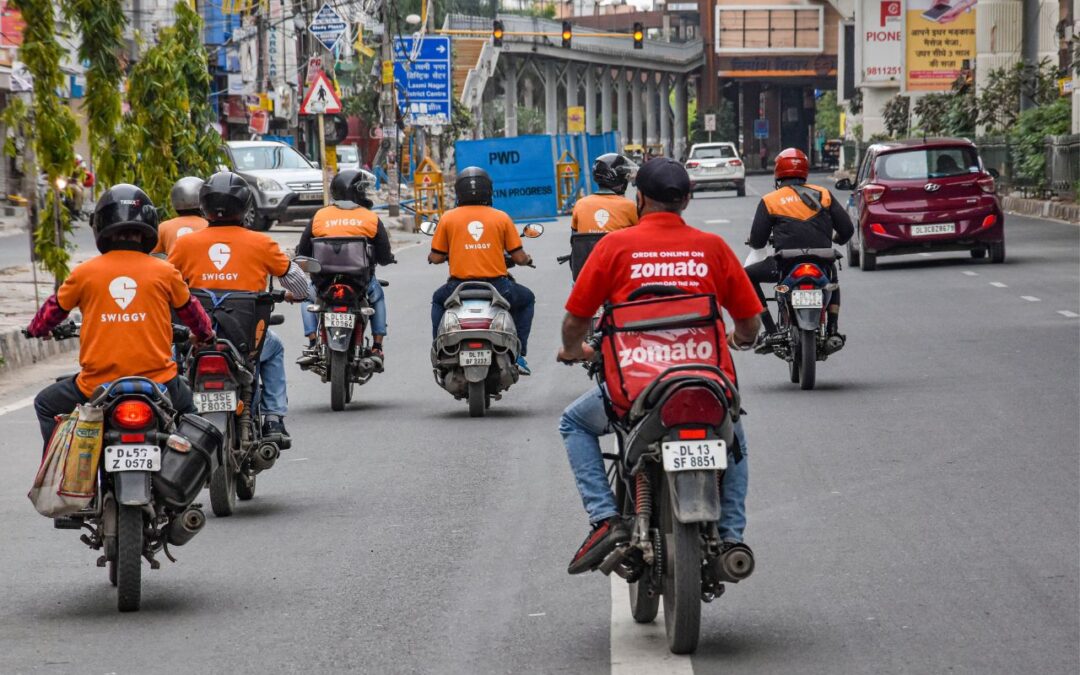Synopsis- As India witnesses rapid growth in food delivery and quick commerce, Swiggy and Zomato continue to contest in a high-stakes duel to establish their dominance in India. This article looks into their market share, finances, innovations, and strategic outlook to gauge who is in the lead in the food tech space in 2025 and what untold fortunes are awaiting.
India’s food delivery scene has changed drastically over the last ten years – Swiggy and Zomato have emerged as the two most notable players in a competitive industry. With cities getting busier and more digitally adopted, millions of Indians are using food delivery platforms for everything from biryani at midnight to a 10-minute grocery run. But what is largely perceived as new-and-improved convenience is also simply a heated battle of market leadership, user stickiness, technology advantage, cash burn, and profits. With Swiggy ramping up its ultra-fast logistics and Zomato (now operating under the Eternal brand) strengthening its grip through Blinkit, the food tech war is no longer just about who delivers better. It is about who scales smarter, faster, and more sustainably. This article breaks down the key metrics, financials, strategies, and future outlook to answer the big question-
Who is Winning the Food Tech War in 2025?
Market Share & User Metrics
Zomato, which has recently renamed itself Eternal, has an estimated 55–58 percent market share in India’s food delivery business, with Swiggy having a robust 42–45 percent market share. Zomato also has a head start in Monthly Transacting Users (MTUs), with approximately 20 million versus Swiggy’s 14 million. Still, Swiggy users spend more per order, with the company having a 6 percent higher Gross Order Value (GOV) per user. This indicates that although Zomato has a larger user base, Swiggy’s users could be more loyal or pay premium prices, perhaps because they have better delivery experiences or value-added services.
Speed & Logistics
- Swiggy is going all-in on super-fast food delivery. It’s “Swiggy Bolt” service that promises to deliver food in 10 minutes, and is operational in more than 500 cities and already accounts for 10–12 percent of total orders. Zomato, on the other hand, tried 15-minute delivery but discontinued it, opting to concentrate instead on scaling Blinkit for grocery and essentials.
- In the quick commerce space, Zomato’s Blinkit holds a premium position. It runs around 639 dark stores in 44 cities versus Swiggy Instamart’s 557 dark stores in 32 cities. This provides Zomato with better metro and tier-2 city coverage and a superior unit economics profile in many geographies.
Financial Performance
- Swiggy (FY25):
- Quarterly loss in Q4 expanded to Rs. 1,081 crore, almost doubling year-on-year.
- Revenue climbed 45 percent to Rs. 4,410 crore for Q4 and Rs. 15,227 crore for the year.
- Losses were principally driven by aggressive investments in Bolt, dark stores, and fleet growth.
- Zomato (or Eternal) FY25:
- Quarterly profit fell 78 percent year-over-year to Rs. 31 to 39 crore.
- Full-year PAT increased to Rs. 527 crore, evidencing enhanced operational efficiency.
- Revenue increased by 64 percent for Q4 to Rs. 5,833 crore, with full-year revenue at about Rs. 20,243 crore.
- Despite a drop in quarterly profits, Zomato remains in the green overall, unlike Swiggy, which continues to post deep losses as it prioritizes growth and logistics investments.
Outlook & Competitive Positioning
- Swiggy is anticipated to record a 28 percent CAGR in revenue growth over the next three years, with EBITDA profitability expected by FY27. Zomato, however, is perceived as a more stable bet with improved marginal structures today and a dominant position in the quick commerce business with Blinkit, which is close to break-even at -0.1 percent EBITDA margin, while Instamart is at a higher loss of approximately -11.7 percent.
- Industry experts point out that Swiggy lags behind Zomato by 7–8 quarters in margin and order value, but also point out that this lag has been due to strategic lags, and not long-term weakness.
Also read: Swiggy Introduces ’99 Store’ with Budget Meals Available in 175 Indian Cities
Operational Strengths and Challenges
- While the two businesses are also experiencing slowing growth in conventional food delivery, quick commerce is on the upswing as the new frontier. But the segment is not as profitable as it seems, especially due to heavy discounting and infrastructure costs.
- Furthermore, both Swiggy and Zomato are in the crosshairs of India’s regulators for suspected anti-competitive pricing and deep discounting. That might affect business models in the future, particularly as the government strengthens e-commerce regulations.
| Key Metrics Comparison | ||
| Metric | Zomato (Eternal) | Swiggy |
| Market Share | 55–58% | 42–45% |
| Monthly Transacting Users | 20 million | 14 million |
| Quick Commerce Reach | 639 stores, 44 cities | 557 stores, 32 cities |
| 10-minute Food Delivery | Not active | Active in 500+ cities |
| Quarterly Profit/Loss (Q4) | Rs. 31–39 crore profit | Rs. 1,081 crore loss |
| Annual Revenue (FY25) | Rs. 20,243 crore | Rs. 15,227 crore |
| Blinkit/Instamart EBITDA | -0.1% | -11.7% |
Both companies should explore new sets of services to create stronger engagement for customers. A recent example is Swiggy’s launch of Rs. 99 Store, which has home essentials like groceries and household products, curated for value-focused consumers anchored in tier-1 and tier-2 cities, with all products priced at a flat price point of Rs. 99. This Store to the Swiggy Instamart, and they are both helpful in diversifying the company’s revenue leverage or building a customer ambassadorship outside of food. On the other hand, Zomato is continuing with Zomato Gold while also providing stronger offers with contentment like faster delivery when you’re going out for a restaurant, pre-order, customer support, and discounts. These actions serve to reinforce their ecosystem of loyalty, and both APIs are showing how they want to play outside of restaurants and food categories by trying to develop sticky touchpoints and service-level interactions tied to affordability and convenience.
What’s Next?
As India’s food tech market matures, the conflict between Swiggy and Zomato is moving from mere user acquisition to profitable scale and service differentiation. With macroeconomic headwinds mounting and the quick commerce segment still evolving, the next innings of this competition will be around:
- Operational efficiency: Which can deliver the most orders per delivery agent profitability?
- Tech-driven personalization: Look out for more AI-powered recommendations and subscription benefits.
- Strategic alliances: Deals with FMCG, cloud kitchens, and logistics operators will ramp up.
- IPO possibilities: Swiggy is gearing up for a public listing — the performance in the next 12–18 months may be decisive.
Conclusion
- Zomato (Eternal) is now leading in market share, revenue, and profitability. It is positioned strongly in the quick commerce category and has a more solid cost base. But Swiggy is innovating at the edges on logistics, user experience, and ultra-fast delivery, and it has deep investor support to continue its aggressive growth strategy.
- The end victor may not be for the fastest or cheapest deliverer, but instead for the person who constructs the most sustainable, scalable, and diversified digital commerce ecosystem. And currently, Zomato holds the scoreboard, but the game is not over yet.
- Undoubtedly, Zomato (Eternal) and Swiggy occupy strong and differentiated positions within India’s food tech and quick commerce categories. Zomato currently has an overall lead in market share, revenue, and profitability based on effective cost containment and a focus on quick commerce through Blinkit, while Swiggy is deploying rapid innovations around ultra-fast-food delivery and consumer experience, with considerable investment backing for long-term growth.
- Rather than indicate an obvious victor, we see a situation that is dynamic and ongoing, whereby each player is leveraging unique strengths. The course of India’s food tech industry will largely be dictated by those who can combine scale, efficiency, consumer trust, and ecosystem. We fully expect that both Swiggy and Zomato will be important forces in the next phase of digital consumption for India as consumer expectations evolve and the category matures.
Written by Adithya Menon





